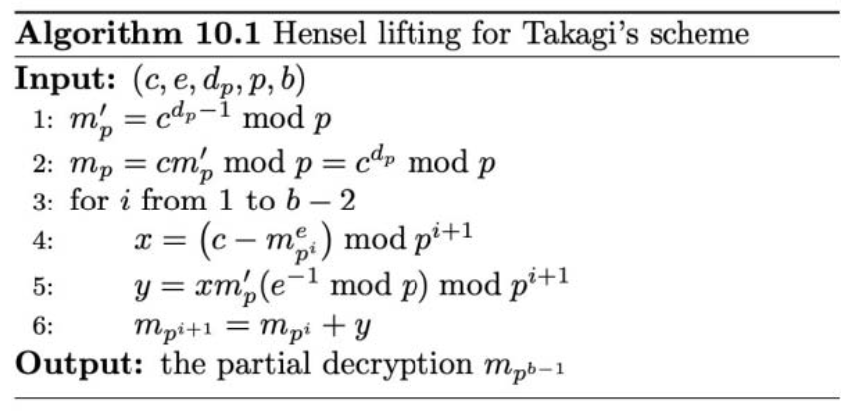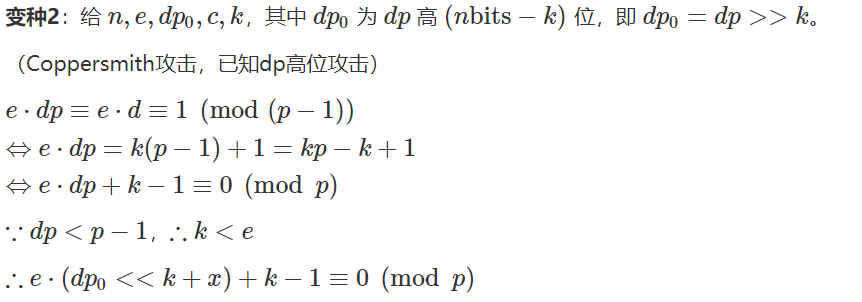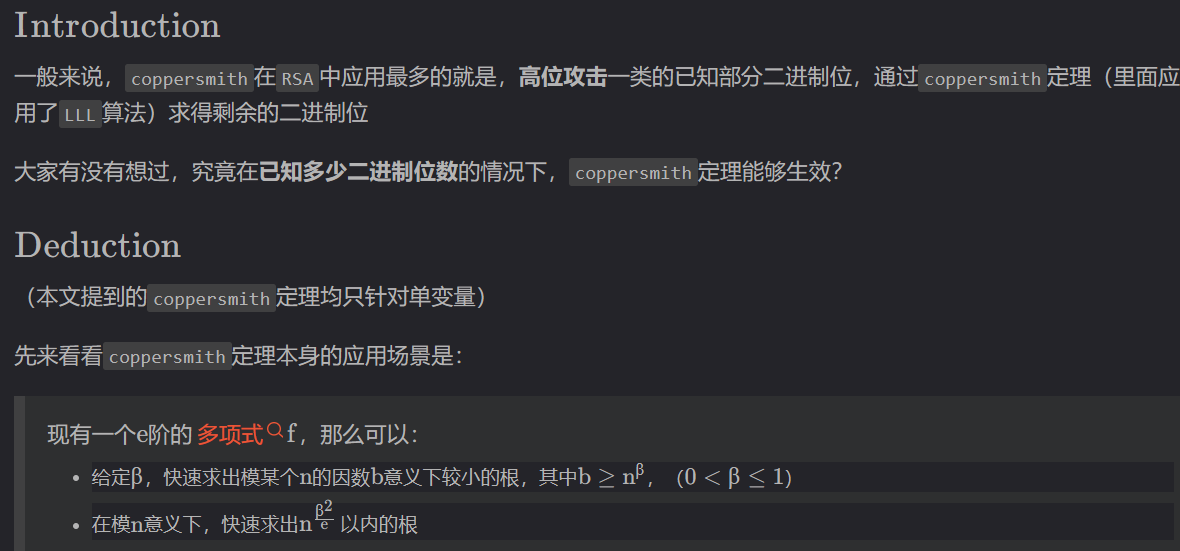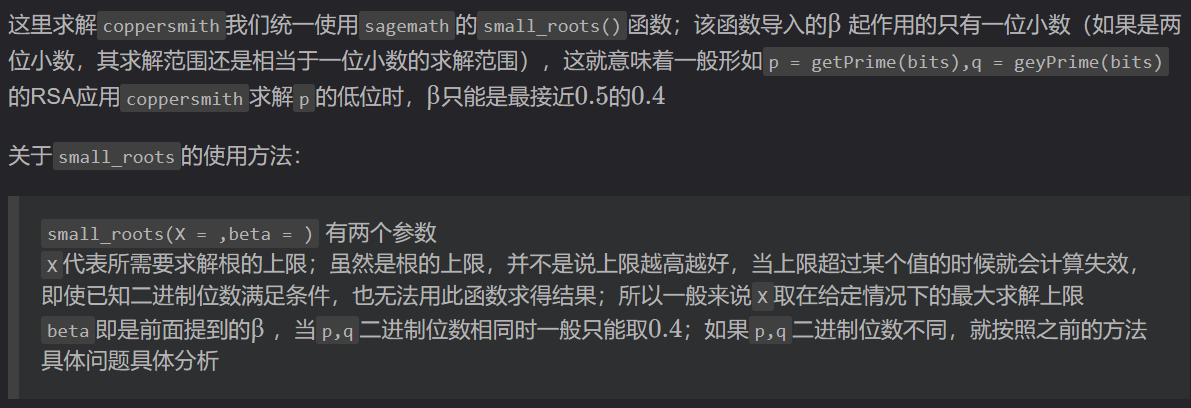Weekly-Descriptions-About-Crypto
The dp_leakage in RSA attacks, the post will introduce some extensions about the dp_leakage, using the example [2020YCB]Power.
Next part will resolve the [2022MIMIC]cry1 which is more easier than the former wp. The former by using polynomial, the latter by using math deduction with fermat_little_theorem.
Both of them will be given full solutions and comparison.
DP_LEAKAGE_EXTENSIONS
EX1: $n = p^{b}\cdot q$
[2020YCB]Power

1 | def dp_hensel(c, e, dp, p, b): |
EX2: Coppersmith attack, know dp high
[qwb2019]Coppersmith

1 | #Sage |
EX3: $p = gcd(m^{e\cdot dp} - m, n)$

TBC
[2020YCB]Power
factorize $n$ to get $p$
solution1-limit
Use the bit_length of $p$ to limit. We can get the equation of $num = dp \times e - 1$, and the num’s bit_length is 526, meaning that num contains some excess factors. We divide these small factors and we will get the true $p$, whose bit_length is 512.
We use yafu to make a factorization.
Deduction:
$$
\varphi(n) = lcm(p-1, q-1) = k_1(p-1) \cdot k_2(q-1)
$$
$$
d \times e \equiv 1 \mod \varphi(n) \equiv 1 \mod (p-1)
$$
$$
dp \equiv d \mod (p-1)
$$
$$
\Longrightarrow dp\times e \equiv 1 \mod (p-1)
$$
Meaning that $num = dp \times e - 1 = k(p-1)$, we limit the bit_length to 512, and we will get the key equation of $p = num + 1$
1 | """ |
solution2-root
Use the equation of $x = 2019\times p^{2} + 2020\times p^{3} + 2021\times p^{4}$ , which is given by Power.py . We can also see clearly from the Power.py that it use discrete log to generate $g_1$, by using $x, y, g$.
So the steps to solve $p$:
discrete_log(y, c1, g)to solve out $x$ (more important)equationsto solve out $p$, the root of the equation is $p$
The real $p$ is defined in $GF(y)$
1 | # step1 |
solution3-crack
Just crack by using the $dp, e, x, y, c1$.
1 | for x in range(1,e+1): |
solve out $m$
solution1-deduce
Use fermat_little_theorem to deduce. From the definition of $c$.
$$
c \equiv m^{e} \mod n
$$
$$
dp \equiv d \mod (p-1)
$$
$$
\rightarrow c^{dp} \equiv m^{dp \cdot e}\mod n
$$
$$
\Longrightarrow \exists k \in \mathbb{Z}, c^{dp}\mod p = m^{k\cdot (p-1) + 1} \mod p
$$
Fermat's little theorem can get the equation of $m^{\varphi(p)}\mod p \equiv 1$.
$$
\Longrightarrow m \cdot m^{k\cdot(p-1)}\mod p \equiv c^{dp} \mod p
$$
$$
\Longrightarrow m \equiv c^{dp} \mod p
$$
So we can run this easy code to get $m$.
1 | m = pow(c, dp, p) |
solution2-hensel
The $n = p^{4}\times q$, which is satisfied the hensel_lifting scheme. The $b$ is 4.
1 | m = int(dp_hensel(c, e, dp, p, b)) |
Over~
[2022MIMIC]cry1
references:
- V&N2020 Fast
- REDHAT2019 Related
part1
To solve out the $p$ and $q$, we ought to make a deduction about the encrypt code.
Known:
$$
g_1 = g^{(p-1) \cdot r_1}\mod p
$$
$$
c_1 \equiv (m \times g_1^{s_1} \mod N )\mod N
$$
Deduction: fermat_little_theorem
$$
g_1 = g^{(p-1)\cdot r1} \mod p \equiv 1
$$
$$
\Longrightarrow g_1 - 1 = k\cdot p
$$
The $N = p\times q$, thus we can get $p$ by $gcd(g_1-1, N)$.
1 | p = gcd(g1 - 1, N) |
solution1-crt
Write the decrypt code by using chinese_remainder_theorem.
1 | def decrypt(c1, c2, p, q): |
solution2-min
$$
c_1 \equiv (m \times g^{s_1 \cdot r_1 \cdot (p-1)} \mod p) \mod N\
\Longrightarrow c_1 \equiv m \mod N
$$
By equation above, we can get a simple way to solve out $m$, for that the bit_length of $m$ is short theoretically.
$$
m = min(c1 \mod p, c1 \mod q)
$$
Convert to code.
1 | m = min(c1 % p, c1 % q) |
part2
Three equations of A, B, C.
1 | cnt = len(Cs) |
solution1-Groebner_basis
1 | PR = PolynomialRing(Zmod(N2), 'x', cnt) |
TBC~
solution2-functions
We are similar to the polynomial equations, thus we make a conversion.
Get the quadradic equations by open to the power of e.
1 | C_ = [] |
Unknown variables $m1, m2, m3$defined on the ring of $\mathbb{Z}$ .
1 | P.<m1> = Zmod()[] |
Substitute the former equations, and get the quadradic equations.
1 | f1 = A[0] * m1 ** 2 + B[0] * m1 + C[0] - int(C_[0]) |
Get the root.
1 | v1 = f1.roots() |
coppersmith边界问题






在
sagemath中应用coppersmith定理的函数有两个:small_roots,coppersmith_howgrave_univariate。这里求解coppersmith我们统一使用sagemath的
small_roots()函数;该函数导入的 $\beta$起作用的只有一位小数(如果是两位小数,其求解范围还是相当于一位小数的求解范围),这就意味着一般形如p = getPrime(bits),q = geyPrime(bits)的RSA应用coppersmith求解$p$的低位时,$\beta$只能是最接近$0.5$ 的$0.4$。
关于small_roots()的使用方法:
1 | small_roots(X = ,beta = ) 有两个参数 |
$X$代表所需要求解根的上限;虽然是根的上限,并不是说上限越高越好,当上限超过某个值的时候就会计算失效,即使已知二进制位数满足条件,也无法用此函数求得结果;所以一般来说$X$取在给定情况下的最大求解上限。
$beta$即是前面提到的$\beta$ ,当$p$,$q$二进制位数相同时一般只能取$0.4$;如果$p$,$q$二进制位数不同,就按照之前的方法具体问题具体分析。
经过测试得到,当未知量小于等于$454bits$时($p$,$q$为$1024bits$),coppersmith定理可以求解
之后改变了$p$,$q$的大小,经过测试发现,当$p$,$q$同二进制位数时,要使用small_roots()应用coppersmith定理求解$n$的某个因数的低位,需要满足未知的二进制位数与因数之间的二进制位数的关系是:
$$
bits_{unknown} \div bits_{p} < = 0.44
$$